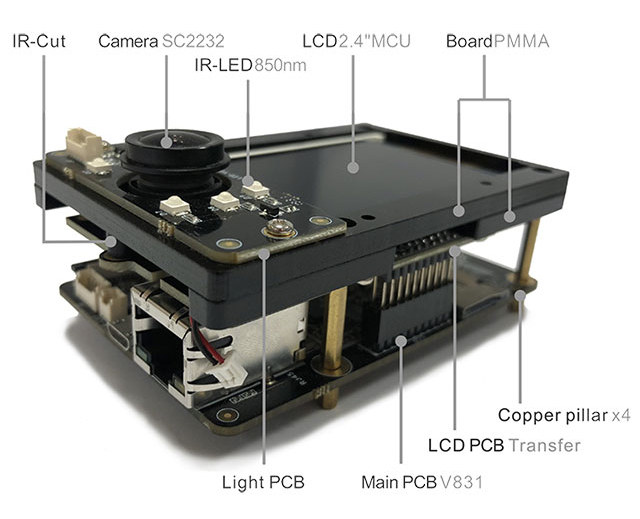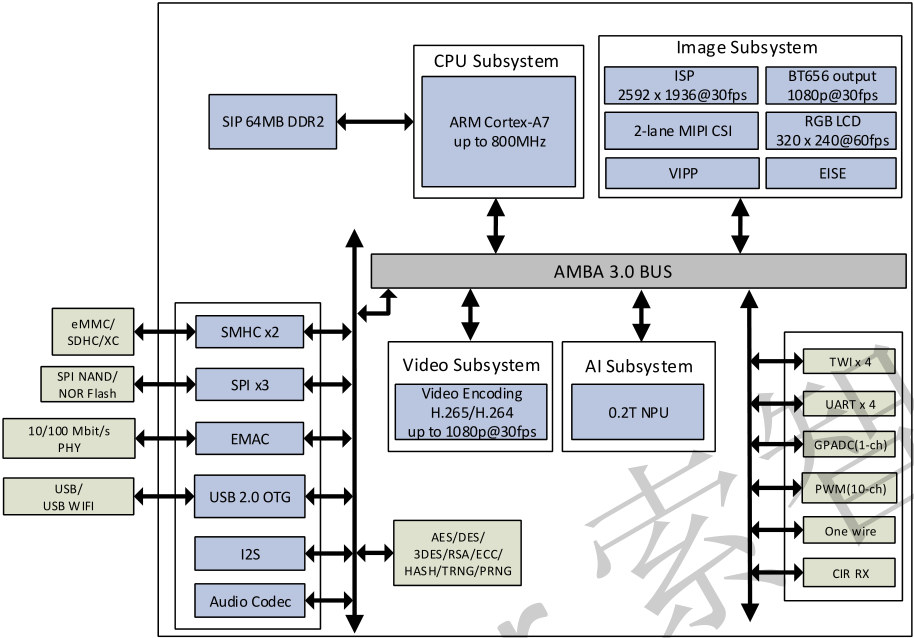In the last year or so, we’ve started to see several camera SoCs with a built-in NPU or SIMD instructions to accelerate face detection, objects detection and so on, starting with the low-resolution Kendryte K210 processor to the 2.5K Ingenic T31 MIPS video processor, or even the 4K capable iCatch V37 camera SoC.
Allwinner introduces several camera processors (V3, V316, S3…) in the past, but none of them included an NPU aka AI accelerator. This has now changed with Allwinner V831 Cortex-A7 Full HD camera SoC also including a small 200 GOPS NPU.
Sochip / Allwinner V831 AI Camera SoC
Specifications:
- CPU – Single-core Arm Cortex-A7 processor @ up to 800 MHz with
NEON, 32KB L1 instruction cache and 32KB L1 Data cache, 128KB L2 cache - AI Accelerator – 0.2 TOPS (200 GOPS) NPU for face recognition, face detection, and “humanoid detection network”
- System Memory – 64MB on-chip DDR2 RAM
- Storage
- SPI NOR flash, SPI NAND flash, eMMC 5.0
- Booting from SPI NOR, SPI NAND, eMMC, SD, USB, UART, one-key FEL
hardware boot select pin or eFuse booting sequence
- Display I/F
- RGB output up to 320 x 240 @ 60fps
- BT656 video output up to 1080p @ 30fps
- Video Subsystem
- Encoder
- H.264 BP/MP/HP up to 1080p60 + VGA @ 60Hz
- H.265 MP up to 1080p90 or 720p30 + 5M @ 30 fps
- H.264/H.265 supports I/P frame, dual-P frame
- JPEG snapshot at 1080p @ 60fps independently
- Maximum 16 regions of interest(ROIs) without encoding for AI
- Decoder – H.264 BP/MP/HP, H.265 MP, MJPEG/JPEG MP
- Encoder
- Camera Support
- 2-lane MIPI CSI input up to 1080p60
- ISP with 2688×2688 maximum resolution, 2592×1963 @ 30 fps
- Electronic Image Stabilization Engine (EISE)
- Lens distortion correction, fisheye, and PTZ calibration
- 2 Video channels: one up to 1080p@60fps, the other up to 720p@60fps
- Adjustable 3A functions, including automatic exposure(AE), automatic white balance(AWB) and automatic focus(AF)
- Highlight compensation, backlight compensation, gamma correction, and color enhancement
- Defect pixel correction, 2D/3D denoising
- Audio – 20-bit audio codec, I2S & TDM interfaces
- Networking – 10/100M Ethernet port with RMII interface
- USB – 1x USB 2.0 OTG
- Other Peripherals
- Up to 54 GPIO interfaces
- 4x UART, 3x SPI, 1x PWM, 4x I2C/TWI, One-wire interface
- 2x SD 3.0/SDIO 3.0 for SDXC cards
- GPADC
- RTC
- Security
- AES, DES, 3DES, and XTS
- RSA512/1024/2048/3072/4096bits, ECC160/224/256/384/521bits
- HASH tamper-proofing algorithms implemented by using hardware, including MD5/SHA/HMAC
- TRNG) and PRNG
- Integrated 1Kbits e-Fuse storage space
- Supply Voltages – Core: 0.9V; I/O: 3.3V
- Package – QFN88, 9 x 9 mm, 0.35 mm pitch
Allwinner V831 is designed for security monitors, driving recorders, police body cameras, and other camera applications that may leverage AI acceleration.
Note we’ve also been told Allwinner V833 is another similar processor capable of handling 4K, but requiring external DRAM. We were unable to find details at this time. [Update: We’ve had the V831/V833 datasheet drop into our inbox this morning, and V833’s MIPI CSI input supports up to 2592 x 1936 @ 30fps RAW data or 4x 1080p@25fps, the encoder is still limited to 1080p90. Cortex-A7 clocked at 1.2 GHz with 400 GOPS NPU]
Sochip V831 development board

Sochip V831 development board is aimed at companies planning to design an IP camera with AI features and is sold for $440 on Alibaba. The chip itself should just cost a few dollars in volumes.
Software and Documentation
You’ll find some WiP documentation on Sochip’s Wiki. The Linux source code (Tina) is available through the company’s git server, but you’d need to provide an SSH public key (id_rsa.pub), a company name, and email address to Sochip to be able to download the code after approval. Full documents are also available via an FTP server, but again you’d need to obtain a username and password from Sochip.
Thanks to Jon for the tip.

Jean-Luc started CNX Software in 2010 as a part-time endeavor, before quitting his job as a software engineering manager, and starting to write daily news, and reviews full time later in 2011.
Support CNX Software! Donate via cryptocurrencies, become a Patron on Patreon, or purchase goods on Amazon or Aliexpress






My sources say V831 $3.00 by the reel and V833 (4K) is $4.50. They also say a more reasonably priced (~$100) V833 dev board is in the works. These chips are brand new and the chip vendors don’t have stock yet. I suspect SDK will be up on github a few weeks from now. Kernel is V4.9. SDK is supposed to be quite similar to the V526 SDK.
This V831 really good bang for the buck at $3.00
The AI unit in the V833 is twice as fast as the one in the V831.
>My sources say V831 $3.00 by the reel and V833 (4K) is $4.50.
I think for context the size of the reel (would have thought these would be a tray..) would be helpful. $3.00 isn’t so good if you have to buy 10,000 of them.
Reels or trays are around 1,000 units. I am not sure how V831/V833 will come from factory. The chip vendors in Shenzhen will buy a reel and then charge you a markup for cutting it into pieces and sending it to you. That markup will be in the range of $0.25/chip in Shenzhen. I found out that V833 comes in 1,680 chip box and V831 comes in 2,600 unit box. There are ten trays inside each box. So you should be able to get the $3 price by buying a box of 2,600 from Allwinner for $7,800. If that’s too… Read more »
>Reels or trays are around 1,000 units.
Trays of similar components are 2080. If you can order 1000 of these and get that price then that’s very good.
Hopefully they didn’t mess around too much and making these work is just a device tree.
V831 SDK is supposed to be very similar to the V536 SDK. You can get the V536 SDK here: https://github.com/lindenis-org?q=536
V831 SDK is only preview, not released yet.
We’ve received the datasheet for V833/V831 processor this morning and added it to the post.
It looks like V833 is still an HD camera chip (not 4K) with support for MIPI CSI cameras up to 2592 x 1936 @ 30fps.
I see what the trick is, it can process 8MP (ie 4K) but that 8MP is split into two streams, 5MP@20fps
+ 1080p@20fps, it can’t make a single 4K video. So this chip is basically a new version of the V3/S3/V3S.
I should be able to receive this board tomorrow, V831
hardware user manual: https://sns.widora.cn/assets/uploads/files/1588166086220-sc1670-v831-development-board-hardware-user-manual-v1.0.pdf
Has anyone located the pinouts for the V831/V833? They aren’t in the preliminary datasheet.
We are trying to determine if the 1080P BT.656 output on the V831 can be used to drive an LCD. The RGB LCD controller is limited to 240×320. We’re also trying to locate a 480×800 LCD with BT.656 input.
I’m a bit surprised you cannot get answers from Allwinner since you must be a customer. Or do they only talk to companies with millions in volume?
I had this type of problem when working for a company working in “low-volume manufacturing” though.
The V831/V833 are in preview right now, they are not released. Sochip is the official dev board manufacturer. Sochip answers basic questions, but their answers to more complex questions are not very good. I have asked this question to Sochip. Their response was to send me more info on how to use the RGB LCD. Even though the question clearly stated BT.656 nothing having to do with BT.656 was in their response.
831 There are two ways to drive LCD, serial-RGB(8bit) or 8080-8bit
But the official development board design is very strange, he mistakenly reused RMII and LCD.
I will design a board to separate their functions.
about why only 320*240. The official reply is bandwidth, so it can be considered feasible to use 320 * 480 30fps.
Unfortunately, it is difficult to find serial-rgb screens now, they are the product of the last data era.
I am solving this problem, I have found a 5-inch 8080-8bit screen.
https://twitter.com/widoraIO/status/1255791539734765569
We have given up on BT.656 screen vendor says all of the chips obsolete and too expensive.
What do you think about a pair of I2S mics instead of mono analog mic? Pair of I2S mic would make beamforming hotword possible. Can you get cheap I2S mics? If cheap enough use four – one on each corner of PCB. Too bad they eliminated the PDM mic interface, PDM mics are cheap.
yes, https://sns.widora.cn/topic/657
I think it can replace K210, it brings us tinalinux, sdio-wifi, 100M net, audio in / out and sd-card, more memory, higher pixel camera(mipi-csi).
The AI unit on both chips (V831/K210) is roughly equal in power (ie not much). I do wish they had made both 64MB and 128MB version like they did with R329.
Have you seen any of the Allwinner AI tools for V831/R329? Can they run a tensorflow model?
I haven’t found the AI compiler tool
The new data of V831 shows that the pin definition of the CPU has changed greatly, so it is not recommended to continue to provide the old data to customers. 2020-05-20
When will you have a PCB ready?
After their announcement, the V831 chip in my hand became a waste product.
I need to be patient and wait for the new official information. :)
Maybe they figured out that this chip needs h.264 decode support. It doesn’t have to be great decode support, just enough to play back saved video.
new V831 chip
Is there a new datasheet? The old datasheet failed to mention that the chip can decode h.264.
datasheet : https://widora.cn/topic/698/